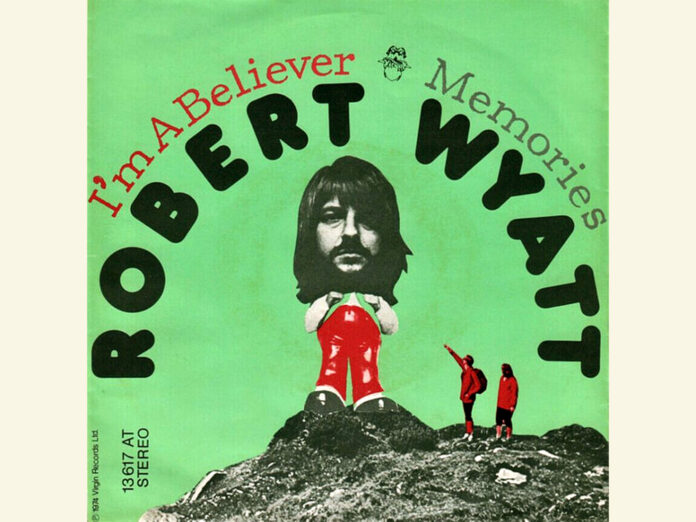WYATT: One of my friends said, “But Robert, is it a great song?” In one exhibition, Peter Blake had a lot of paintings by monkeys, and somebody said to him, “Oh, they’re not very good paintings.” He said, “Well, they’re pretty good for monkeys!” So for a Monkees song, it’s a pretty good song. I don’t feel the need for any hierarchies [in music] and there was a slight statement I was making about that. Not being in a group you can do one-off things, have a particular band for a particular thing. And for “I’m A Believer” it was the right group.
FRED FRITH: Robert used to show up at Henry Cow gigs and never failed to say nice things about us. Bill McCormick and Francis Monkman approached me about joining the reforming Matching Mole, but then Robert had his accident and that was the end of that. I visited him in hospital and we became close. Henry Cow had opened for Pink Floyd on numerous occasions between 1969 and 1972, so Nick and I had brushed shoulders. I’d had the unnerving experience of David Gilmour sitting at my feet checking me out while performing… I think Robert and I felt an affinity on many levels, musical, political and especially a shared enjoyment of life’s absurdities.
WYATT: I did take the liberty of buggering around with the chords to “I’m A Believer”. I played the piano part to Dave, and he played what I played him really. Dave’s great like that, he can just sort of do anything. Amazing man.
MACRAE: Robert would certainly have indicated what he wanted played and I may have thrown in an idea. I think the arrangement was largely osmotic and a natural process. Robert has great mental energy, and this energy acted as a catalyst in generating ideas from others involved.
WYATT: I wouldn’t have thought the recording took any longer than a day, maybe another day for mixing? I would have thought I’d have done the vocals after, especially as there is some double-tracking there. I remember there was a bloke from Neil Diamond’s publisher who hung around all the time, not doing anything at all, and I thought, ‘That’s an easy job.’ He just traipsed around after us. “I’m from the publishing company.” Just helping himself to the freebies knocking about…
MASON: Producing Robert didn’t entail an enormous amount of hard work. He really just wanted a bit of assistance in the technical side. But I certainly didn’t need to tell him anything about how the music went.
WYATT: Nick made some crucial decisions. He’s also funny. He used to come out of a take and you’d say, “That’s great.” And he’d say, “Yes, it does a bit, doesn’t it.” A very funny man!
MASON: We probably did the backing tracks in an hour or two. We spent longer putting Fred’s stuff on than anything else, the violins and so on. That was all Fred’s idea, we let him loose on it.
FRITH: There was the instrumental break which they didn’t have a plan for, so I wrote the string arrangement on the spot and recorded it. Then I finished up with the lead guitar stuff, which was a first take, just doing whatever came to me in one pass of the song, using my 1958 Gibson 345, volume pedal and Electro Harmonix Big Muff distortion – that was pretty much all I had. I remember Nick being super-complimentary about it and me feeling like a million bucks!
WYATT: Nick used to make this joke about a “Pink Floyd tempo”. We said, “We’re going to do it a bit faster,” and it was the first time he broke into a bit of a sweat!
MASON: It was probably faster than all the Pink Floyd tempos throughout history. We always kept to about 70bpm max. My doctor told me never to play faster than my pulse rate… But I was a lot younger and fitter, then, so it was fine.



